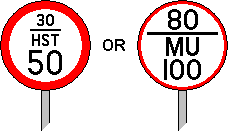|
|
|
|
|
|
|
|
|
The conventional signs for non-standard differential speed restrictions are based on the standard circular speed sign, with the addition of identifying letters [13.66]. An elliptical sign is available for areas of limited clearance or for speeds composed of three figures, e.g. "100" [13.67]. Unlike some earlier signs applicable only to HSTs (see [13.37 & 13.41]), the new signs do not override any subsequent signs indicating a lower speed; there is therefore no equivalent to the termination sign (see [13.38 & 13.42]).
The types of trains to which the signs may apply are identified by the codes below:
Generally where these signs are installed, a higher speed applies to the specified type of train indicated, except that a lower speed may apply where "LH", "EMU", "LUL", "CS" or "S7" is shown [13.68]. Class 185 'Desiro' diesel multiple units, introduced in 2006, are not permitted to run at higher speeds shown on "MU" or "DMU" signs. Exceptionally, more than one code may be displayed on a sign [13.69].
|
Exceptionally, a directional arrow may point upwards in addition to one pointing left or right [13.70], to indicate that the speed sign applies to the straight route as well as the diverging route. |
|
Local variations exist in the signing of non-standard differential PSRs, where the two speeds are combined on a single sign [13.71 - 13.74] or advance warning indicator [13.75 - 13.77].
 |
 |
|
[13.71] Non-standard Differential Permanent Speed Restriction Sign (combined).
Area: Predominantly Western Region Usage: Medium Status: Uncertain |
[13.72] Non-standard Differential Permanent Speed Restriction Sign (combined).
Area: Various Usage: Low Status: Uncertain |
|---|---|
 |
 |
|
[13.73] Non-standard Differential Permanent Speed Restriction Sign (combined).
Area: Various Usage: Medium Status: Uncertain |
[13.74] Non-standard Differential Permanent Speed Restriction Sign (combined).
Area: Various Usage: Medium Status: Uncertain |
 |
 |
 |
|
[13.75] Advance Warning Indicator applicable to a non-standard differential permanent speed restriction (combined).
Area: Various Usage: Medium Status: Uncertain |
[13.76] Advance Warning Indicator applicable to a non-standard differential permanent speed restriction (combined).
Area: Various Usage: Low Status: Uncertain |
[13.77] Advance Warning Indicator applicable to a non-standard differential permanent speed restriction (combined).
Area: Various Usage: Low Status: Uncertain |
|---|
|
One variant type of combined non-standard differential speed restriction sign has the code letters indicating the type of train presented as a suffix after the relevant speed [13.78]. |
|
On parts of the Eastern Region (Great Eastern Main Line and branches), a single-letter suffix after the lower figure (higher speed) indicates the type of train to which the restriction applies [13.79 & 13.80]. The suffixes used on these signs are:
It was the opening of the Channel Tunnel in May 1994, linking the hitherto isolated railways of Great Britain with those in France, that first necessitated the presentation of permissible speed information in both miles per hour (MPH) and kilometres per hour (KMH). Signs showing both [13.81 - 13.83] were provided in the vicinity of the Channel Tunnel terminal at Dollands Moor and Cheriton for the benefit of continental drivers working into the UK.
 |
 |
 |
|
[13.81] Permissible Speed Sign showing both MPH and KMH.
Area: Dollands Moor / Cheriton Usage: Low Status: Historical |
[13.82] Permissible Speed Sign showing both MPH and KMH.
Area: Dollands Moor / Cheriton Usage: Medium Status: Obsolescent |
[13.83] Advance Warning Indicator showing both MPH and KMH.
Area: Dollands Moor / Cheriton Usage: Low Status: Historical |
|---|
|
|
|